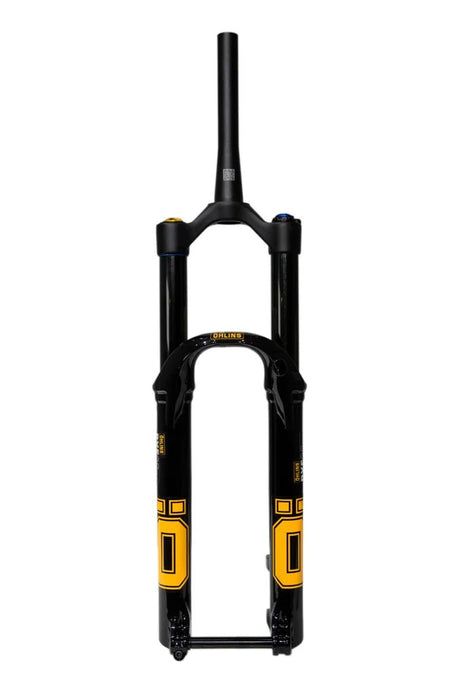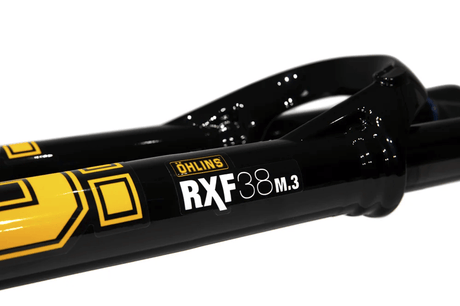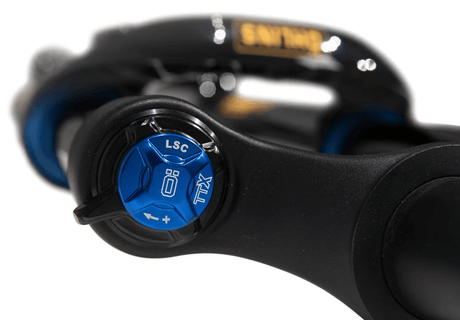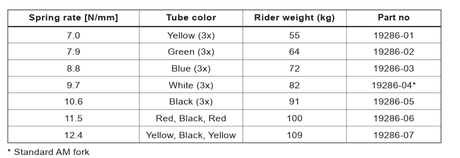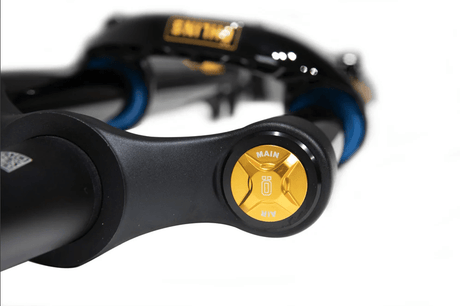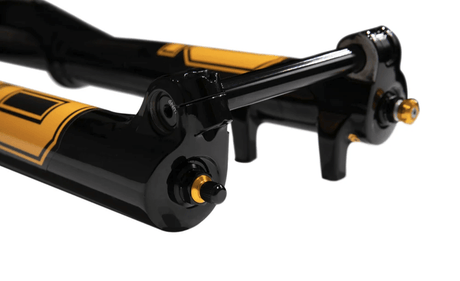
WATCH THE VIDEO
Ohlins updated much of their suspension range this year, and we’re taking a close look at their third generation RXF38 enduro fork, along with the second-generation TTX2Air shock. Many of the updates made to the RXF38 have also been applied to the dual crown DH38 and the lighter weight RXF36, each packing very similar technologies into their respective chassis. While things have certainly changed, this is a minor update relative to the complete redesigns we’ve seen in the past. Ohlins is sticking to their guns with a slightly updated TTX18 damper and three-chamber air system, packed into a revised chassis that’s said to reduce friction and increase traction. In the new TTX2Air, they’ve made the switch from an IFP to a bladder system, and less chassis friction to boot. What’s not to love?
Ohlins has typically been seen as a more race-focused brand compared to their competitors, and they are no strangers to the top of the podium. Even their boxes are adorned with photos and stories from their success in motorsports competitions. They’ve been winning world championships since the 1970s, and Loic Bruni has contributed a handful of DH titles to their trophy cabinet. That doesn’t mean you need to be a world champion to ride this Swedish gold suspension, and I’ve enjoyed my time getting to know the latest generation of this third-party suspension platform.
I rode the previous generation of this suspension extensively and came away impressed at how effectively and differently Ohlins approached the same goal of smoothing the wildly varying terrain we encounter compared to Fox and RockShox. Before riding the Swedish alternative, I had the impression that Fox and RockShox suspension performed quite differently from each other, but Ohlins helped me see that they’re more similar than they are different. In the balance between the damper and the air spring controlling the front and rear wheels, both Fox and RockShox lean more heavily on the air spring, while Ohlins gets more support from the damper than either of them. I found this to be the case for both the RXF38 and the TTX2Air, and we’ll take a closer look at the fork first.

Updated decals and shiny lowers are impossible to miss
RXF38 m.3 Details
|
Now on its third generation, the RXF38 is the burliest single-crown fork offered by Ohlins, aimed directly at long-travel enduro bikes. As the name implies, it uses 38mm stanchions and comes in 160, 170, or 180mm of travel supplied by the three-chamber air spring. Ohlins also offers a coil-sprung version, which comes in 170mm of travel but can be adjusted to between 130mm and 180mm. Regardless of spring type, the RXF38 uses its TTX18 damper, and the stanchions have a new micro-polished surface treatment for lower friction and increased longevity. Glossy paint makes for easier cleaning and better resistance against scratches, and the decals are also updated to signify the third generation. Externally, the TTX18 damper is unchanged, with the same 15 clicks of low-speed compression, 2 clicks of high-speed compression, and 15 clicks of rebound. Internally, the only update is a different shim stack in the compression circuit of the RXF38 m.3 compared to the m.1 and m.2. Ohlins has opted for a slightly lighter compression tune, changing from the C40 to the C30. Ohlins has a “settings bank” for the TTX18 damper of compression and rebound tunes to simplify things for riders who are looking to get a custom tune. In the bank of available tunes, C30 is on the lighter side of things, with tunes ranging from C20 to C60. In this setting bank, Ohlins outlines exactly which shims are used in each tune, making it a little more accessible for a home mechanic to install their own custom tune in the garage. |
RXF38 m.3
|

Something I loved about the RXF38 m.2 was the three-chamber air system. It opens up a world of adjustability that can’t be matched by a standard two-chamber air system, and the same air spring is used in the RXF38 m.3. Well, it’s the same air spring, but sports a different volume spacer setup from the factory. My biggest critique of the RXF38 m.2 was that it lacked sensitivity off the top until I removed the negative volume spacer that came in the air spring, and now that negative volume spacer is no longer pre-installed in the fork. There’s also a larger volume spacer in the main air spring, and the ramp chamber also has three volume spacers installed in it. All of these changes were made to lower the pressures used in the ramp chamber, as many riders were using the maximum pressure of 250 psi.
The air spring can be removed without dropping the lowers, making a travel change or air spring service a potentially super quick job. That’s thanks to the air spring being completely contained as a cartridge rather than using the insides of the stanchion walls as a component of the air spring.
One more change is the addition of a spring booster on the bottom of the damper. This aims to close off the air cavity between the damper cartridge and the stanchion and create an additional air spring in the lowers, hence the name “spring booster”. Ohlins debuted this in the RXF36 m.3, but this is the first time it’s been used in the RXF38. Ohlins claims that the most influential change to the RXF38 m.3 isn’t anything inside the fork, but is actually the new micro-polish finish on the stanchions. This new finish should make the fork smoother and last longer, with pretty much no downsides that I can think of. It uses the classic blue SKF fork seals, but still lacks any kind of bleeder valves that have become commonplace on other forks.
Riding the RXF38 m.3
While I struggled a bit to get the previous generation RXF38 set up, that wasn’t the case at all with the RXF38 m.3. I found the recommended air pressure settings to be much closer to where I ended up, whereas with the m.2 I found myself way above the recommended pressures. That’s most likely attributed to the increased progression baked into the three-chamber system, and I ran much less pressure in that chamber to get the same ride feel as before. Mission accomplished, Ohlins.
I can’t feel a distinct transfer from using the full volume of the fork to losing the ramp-up chamber volume when deep in the travel, and tuning the ramp-up with the ramp-up chamber is very noticeable. Adjusting ramp-up pressure has a very similar effect to adjusting the volume spacers of a standard Fox or RockShox air spring, but with a couple of advantages. First, you can get very precise with the pressure in the ramp-up chamber instead of being confined to larger jumps in progression with volume spacers. I know many riders have wished they could add half a volume spacer to their conventional air springs, and several people have gone as far as 3D printing their own custom volume spacers to get the exact ramp up they’re looking for!
Another advantage is inherent to the three-chamber system, and that’s that by playing with the ratio between the main positive air chamber and the ramp-up chamber, you can fine tune exactly where in the travel the progressivity is. Ohlins recommends approximately double the pressure in the ramp-up chamber compared to the main chamber, and adding ramp-up pressure relative to the main chamber will cause the progression to start earlier in the travel. If you add pressure to both positive chambers, then you’ll get more progression later in the travel. Not only that, but you can also play with volume spacers in both of these chambers, as well as the negative chamber, opening up endless air spring tinkering opportunities. That’s a dream come true for some, but a nightmare for others. Luckily, the recommended settings weren’t far off from where I ended up.
 Standard compression and air adjustments are found up top |
 Ramp up knob and rebound found down under
|
As for the damper, Ohlins still has something special with the TTX18. While it doesn’t do anything radically different from its competitors, Ohlins’ damper manages to set the RXF38 apart from the rest. You’ve still got the classic low-speed compression, high-speed compression, and rebound knobs to play with, but the TTX18’s highly damper compression characteristics have me very impressed. Truthfully, I don’t know where to point at in this damper to explain where this performance comes from, but it’s able to hold my front end stable through those truly rough sections of trail without turning me into a bobble-head more consistently than other forks. My front wheel just tracks the ground no matter what kind of unpredictable chunder I find behind a blind crest, and manages to smooth out those bigger impacts slightly more effectively than a GRIP X2 Fox 38 or Charger 3.1 RockShox ZEB.
Tuning the damper is also different from the competition, and I find it to be much simpler on the RXF38. While it’s got the same high and low speed compression knobs as other dampers, I only tinker with the low speed compression knob of the TTX18. I’ve found that adding any high-speed compression really compromises the sensitivity of the fork, and leaving it wide open like a trophy truck through the desert is perfect for my preferences. It’s got a similar feature to the GRIP X damper with its “lockout mode” for efficient climbing, and it certainly makes the fork incredibly stiff when fully closed. This wasn’t something I used after testing its functionality, and I can’t imagine many riders are buying this fork for its climbing efficiency.
Luckily, the low-speed compression does wonders for tuning this damper, and there was a wide range of adjustability that allowed me to easily find a comfortable setup. I started right in the middle and ended up adding a few clicks to get the support I was looking for. Now I’m just three clicks from closed, and I’m impressed at how the LSC circuit can do the job of both the high and low speed compression. Adding LSC effectively builds support in those high shaft speed scenarios I would typically use HSC to tune, as well as giving the mid stroke support I expect from LSC. I imagine that some riders will feel limited by the largely unusable HSC knob, but I really got along with the LSC characteristics.
While riding, the RXF38 m.3 stays high in its travel, largely thanks to the mid stroke support from the firm compression damping, and is incredibly confidence-inspiring in steep terrain. High-quality mid-stroke support is my favorite part about this fork, and the RXF38 manages to preserve its travel and stay in the mid-stroke very consistently, efficiently managing its travel through big impacts. Efficiency is the word that keeps coming to mind with this fork, and it feels like it manages to consistently use less travel than other high-end 38mm forks I’ve used, giving it that “racey” feel. But when you need more travel, it’s there.
Big hits are effectively managed in tandem by the TTX18 damper and ramp-up chamber, giving plenty of bottom-out support even with the recommended pressures. Ohlins increased the RXF38’s progression for this generation, but didn’t change their recommended pressures, which means that I now generally agree with their recommended air pressure settings. I still used my shock pump to get the main chamber up to 105 psi, but the recommended 200 psi is exactly what I’m looking for in the end stroke.

In case you forgot
In the initial stroke, the RXF38 m.3 is incredibly sensitive and has very similar initial stroke characteristics to the competition. I found this to be true with the second generation as well, but only after the negative volume spacer was removed to help pull the fork into its travel. Now, the volume spacer comes removed as standard from the factory, which I certainly appreciate. While some riders may prefer less sensitivity in the initial stroke, I’ve read enough complaints about forks being “harsh” to know that lots of people are interested in that small bump sensitivity.
One fork that does match and surpass the RXF38 in how much confidence it inspires is the Fox Podium. That’s certainly an apples-to-bananas comparison, and while I do think the RXF38 m.3 is best in class among upside-down single crown forks, it can’t match the stiffness or comfort of an inverted fork like the Fox Podium. Compared to other upside-down 38mm stanchioned forks, the RXF38 has very similar stiffness characteristics. I would say it’s just about as stiff as a Fox 38, and slightly stiffer than the ZEB, and certainly leans more in the al dente rather than under underdone direction.
Unfortunately, I’m currently nursing a broken finger, which got in the way of testing the coil spring for the RXF38. Ohlins was kind enough to send us a conversion kit and a load of springs for testing, which I’m really looking forward to putting some miles on in about a month or so. It might be the perfect fork mod for my situation, as I’m hoping the sensitivity of a coil spring can help mute the chatter that I assume will aggravate a freshly healed finger bone.
TTX2Air m.2 Details
|
This is the second generation of the Ohlins TTX air shock lineup, with Ohlins offering both TTX1Air and TTX2Air shocks, just like before. Both the TTX1Air and TTX2Air use the same damper, but different air springs. We affectionately call the TTX1 the Slim Jim, as it has a narrower and lower volume air can compared to the high volume TTX2. Ohlins says the TTX2Air is preferable if your frame uses a progressive suspension design, while the TTX1Air is optimized for bikes with more linear suspension designs. Neither shock is “better” than the other, and they just suit different suspension designs. As my Transition Sentinel offers a modern, progressive suspension design, I’ve been riding the TTX2 Air, but the vast majority of my impressions of this TTX2Air m.2 would be the same for the TTX1Air m.2. While their coil shock, the TTX22, is offered in a wide variety of size options for everything from trail bikes to downhill bikes, the Ohlins TTX Air shocks are only available in trail and enduro bike sizing. If you want to run an Ohlins air shock on your downhill bike, that’s too bad! |
TTX2Air m.2
|

|
Ohlins’ air shocks have always been overshadowed by their coil shocks, but the TTX2Air m.2 is nothing to be sniffed at. The second generation of this shock looks remarkably similar to its predecessor at first glance, with the only visible changes being the decals, but the internals have been completely redesigned. Much like its contemporaries, the TTX2Air m.2 is chasing coil-like sensitivity, paired with the progression and low weight of an air shock. With a high-volume air can and twin-tube damping, it’s got the necessary ingredients to do exactly that. Inside the shock, the TTX2Air m.2 uses a bladder-style damper, offering a wide range of damping via the external adjustments. Those external adjustments are the same found on the fork: low speed compression, high speed compression, and rebound. Both LSC and rebound use a 3mm hex wrench, while the HSC features a tool-free dial. All three adjustments are found on the piggy back of the damper, and the air valve is sprouting right out of the air can. Sporting an oddly similar silhouette to the new transverse reservoir equipped 2026 Fox Float X2, the TTX2Air m.2 doesn’t have quite as many adjustments as either the Float X2 or the RockShox Vivid, but it still manages to compete in its pure suspension performance on trail. |
Riding the TTX2Air m.2
While forks and shocks have the same job of compressing linearly to control the motion of a wheel, they’re fed very different inputs. Everything your fork handles is translated directly from the front wheel to the axle, with the only variables between the trail and your fork’s performance being the tire and front wheel. That’s an incredibly direct connection when compared to the path force travels through before it meets the rear shock. Starting with the same wheel and tire interface, there’s a slew of bearings, frame material, and leverage ratios influencing every millimeter of rear shock travel. The good news is that I’ve been testing several high volume air shocks on my Transition Sentinel recently, which have all been subjected to the same variables, and the TTX2Air m.2 has performed admirably.
|
Initial setup was pretty standard, and I had no issues equalizing the positive and negative air chambers while getting to 30% sag. Less pressure was required in the TTX2Air m.2 compared to the Vivid and Float X2 to hit the sag I was looking for, but I ended up increasing pressures and reducing sag in the long term. That brought pressures more in line with the competition. My approach to tuning the TTX2Air’s damper is incredibly similar to tuning the TTX18 damper in the fork, as the external adjusters function almost identically. I leaned heavily on the LSC to tune the feel of the shock, while leaving the HSC wide open. With just a couple clicks of HSC, and the final click functioning as a climb switch, I found that adding any HSC wasn’t for me. Leaving it wide open gave me the performance I was after, giving me support in those bigger impacts while leaving the shock sensitive through the chatter. Ohlins’ goal with this shock is imitating a coil in its initial stroke, while preserving the progression of an air shock deep in the travel. Coil like sensitivity is not how I would describe this shock’s initial stroke, but there are flavors of coil performance when the shock changes direction. The TTX2Air has a fluttery and light nature while making subtle movements that’s reminiscent of a low friction coil shock. But the initial stroke is more firm than any coil shock, and doesn’t quite match the sensitivity of the most coil like air shock, the RockShox Vivid, with its TouchDown technology in the damper. |
 |
Where this shock shines is during moments where you’ve pulled up over a blind rise, only to find a heinous rock garden that you’re sure will buck you off the trail and send you hiking home. But with its stiffer damping than other air shocks, it’s able to manage those dh bike worthy scenarios with marginally more composure than comparable air shocks. I think that adding a stiffer compression tune to either a Float X2 or a Vivid could help them find a similar composure. The delta between the compression damping in the TTX2Air m.2 and those other two shocks is smaller than the delta between the fork’s compression damping that I talked about earlier, and I wish that Ohlins leaned in harder to the stiffer damping in this shock. That heavily damped feel really sets that fork apart from the rest, and while the TTX2Air m.2 is slightly more damped than other options, I think Ohlins could have differentiated this shock a bit more with some stiffer damping.

Who is this suspension for?
Ohlins has historically been marketed as race specific suspension, but this latest generation strays ever so slightly from that narrative. With a marginally lighter damping tune and a focus on comfort, the RXF38 m.3 and TTX2Air m.2 are both right at home on any enduro bike, whether it gets between the tape or not. Ohlins certainly hasn’t lost their highly damped and supportive suspension ethos, but they’ve dialed it back one click to appeal to a wider audience. Overall, the RXF38 m.3 steals the show as my current favorite non-inverted single crown fork, while the TTX2Air m.2 slots in among several high volume air shocks as a worthy contender.

